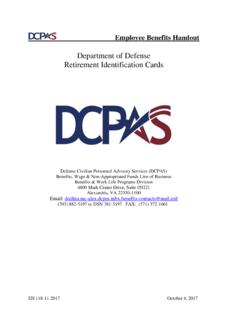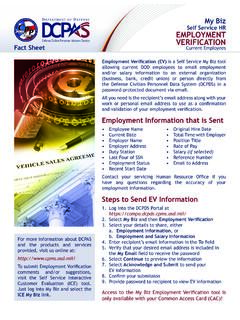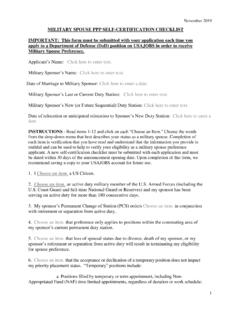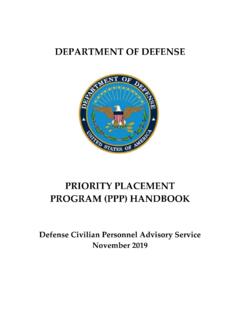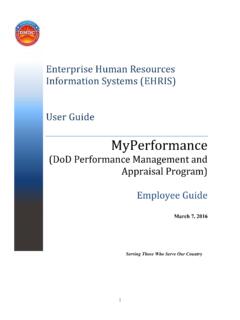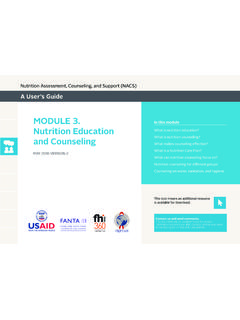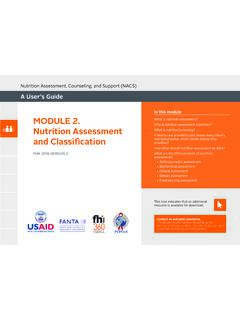Transcription of DEPARTMENT OF DEFENSE
1 DEPARTMENT OF DEFENSE . PERFORMANCE MANAGEMENT. AND APPRAISAL PROGRAM. TOOLKIT. THIS TOOLKIT SUPPLEMENTS DEPARTMENT OF DEFENSE INSTRUCTION VOLUME 431, DOD CIVILIAN PERSONNEL MANAGEMENT SYSTEM: PERFORMANCE MANAGEMENT AND APPRAISAL PROGRAM, BY PROVIDING. COMPREHENSIVE INFORMATION, ADVICE, AND GUIDANCE FOR ADMINISTERING THE. PERFORMANCE MANAGEMENT AND APPRAISAL PROGRAM. APRIL 2016. TABLE OF CONTENTS. INTRODUCTION .. 1. Purpose ..1. Coverage ..1. Fact Sheets ..1. Additional Assistance ..1. CHAPTER 1 - PERFORMANCE MANAGEMENT & APPRAISAL PROGRAM ..2. CHAPTER 2 - PLANNING PERFORMANCE ..5. Overview ..5. Performance Plan .. 6. Linking Performance Plans to DoD Core Values and Organizational Goals .. 7. Performance Elements and Standards Understanding the Difference ..9. Communicating Performance Expectations .. 12. Modifying the Plan During the Appraisal Cycle .. 12. CHAPTER 3 - MONITORING PERFORMANCE .. 14. Overview .. 14. Progress Discussions and Reviews .. 17. Performance Discussion and Progress Review Preparation for Employees.
2 17. Performance Discussions Related to Less Than Fully Successful Performance .. 18. Training or Developmental Opportunities .. 19. Employee Engagement .. 21. CHAPTER 4 - EVALUATING PERFORMANCE .. 22. Overview .. 22. Employee Input .. 23. Narrative Statement .. 23. Performance Summary Levels .. 24. Deriving and Assigning a Rating of Record .. 25. Final Performance Appraisal Discussion .. 26. Communicating the Performance Appraisal .. 27. Resolving Disagreements Over the Rating of Record .. 27. CHAPTER 5 - RECOGNIZING AND REWARDING PERFORMANCE .. 28. Overview .. 28. DoD Recognition and Reward Program .. 28. I|P age Achievable Recognition and Reward .. 29. CHAPTER 6 - PERSONNEL ACTIONS .. 30. Overview .. 30. Promotion .. 30. Within-Grade Increases (WGI).. 30. Quality Step Increases (QSI) .. 31. Probationary/Trial Period .. 32. Probationary Period for Supervisors and Managers .. 33. CHAPTER 7 - SPECIALLY-SITUATED EMPLOYEES .. 34. Overview .. 34. Employees on Detail .. 34. Matrixed Employees.
3 35. Employees Performing Representational Responsibilities .. 36. Extended Absence .. 36. Out-of-Cycle Appraisals .. 36. Employees Who Transfer or Supervisors Who Leave During the Appraisal Cycle .. 37. CHAPTER 8 - ADDRESSING PERFORMANCE ISSUES .. 38. Overview .. 38. Communicating Expectations and Performance Deficiencies .. 39. Addressing and Resolving Performance Deficiencies .. 39. Providing an Opportunity to Improve .. 40. Within Grade Increase (WGI) Delay or Denial .. 41. Reassignment, Demotion, or Removal Based on Unacceptable Performance .. 42. CHAPTER 9 - MyPERFORMANCE .. 43. APPENDIX A: ALIGNING EMPLOYEE PERFORMANCE PLANS WITH ORGANIZATIONAL GOALS .. 45. GLOSSARY: DEFINITIONS.. 47. II | P a g e PERFORMANCE MANAGEMENT &. APPRAISAL PROGRAM TOOLKIT. Labor and Employee Relations Division INTRODUCTION. PURPOSE. This toolkit supplements DEPARTMENT of DEFENSE Instruction , DoD Civilian Personnel Management System: Civilian Performance Management and Appraisal Program, by providing comprehensive information, advice, and guidance for administering the Performance Management and Appraisal Program.
4 It is designed to inform supervisors, human resources personnel, and employees on the ongoing performance management process, including planning, monitoring, evaluating, and recognizing and rewarding employee performance. It will promote compliance with performance management policy, as well as consistent application of performance culture principles across the DEPARTMENT . This toolkit includes details about procedures of the DoD performance management cycle. COVERAGE. The DoD Performance Management and Appraisal Program and this Toolkit apply to a majority of DoD appropriated fund civilian employees, except: (1) employees excluded from coverage under applicable laws and (2) employees covered by other performance programs as established through applicable regulations. A complete list is available at Appendix 3A: Exclusions from Coverage in the DEPARTMENT of DEFENSE Instruction The Performance Management and Appraisal Program cultural principles of continuous communication and shared understanding of performance expectations apply to any performance management program.
5 FACT SHEETS. A variety of Fact Sheets cover topics such as how to prepare for a performance discussion, how to write goals that are aligned to the organizational mission, and how to write effective employee input and performance ratings are available on the DEFENSE Civilian Personnel Advisory Service, Labor and Employee Relations Division (DCPAS LERD), Performance Management webpage at Employee-Relations/ ADDITIONAL ASSISTANCE. If you have questions about the information in this toolkit, contact your servicing Human Resources Office or DCPAS LERD at 1|P age PERFORMANCE MANAGEMENT &. APPRAISAL PROGRAM TOOLKIT. Labor and Employee Relations Division CHAPTER 1 - PERFORMANCE MANAGEMENT & APPRAISAL. PROGRAM. WHAT YOU SHOULD KNOW: A culture of high performance focuses on employee engagement, development, and accountability. Performance management is one of the most important aspects of Supervisory and Managerial responsibilities. Benefits of a successfully implemented Performance Management and Appraisal Program include an organization that is directly aligned with its goals as well as a motivated workforce.
6 Performance management is an on-going process that involves continuous feedback and two-way communication between supervisors and employees. The DEPARTMENT is committed to maintaining a high-performance culture through a fair, credible, and transparent Performance Management and Appraisal Program that fosters timely employee recognition and rewards. Effective efforts of supervisors and employees align with organizational goals, promote consistency in performance review, and motivate employees to perform at their best. Performance management increases individual success and accountability, achieves agency and organizational goals, and improves operational efficiency. An effective performance management program helps supervisors recognize their employees' full performance potential by differentiating between high achievers and those requiring performance improvements, thereby assisting the DEPARTMENT in meeting its mission and goals. Performance management focuses on a continuous year long process of communication, development, and results rather than waiting until the end of the performance period.
7 The Performance Management and Appraisal Program encourages active two-way communication between the supervisor and the employee throughout the performance appraisal cycle. Successful employee performance is essential to accomplishing mission goals. A successful Performance Management and Appraisal Program ensures work performed by employees accomplishes the goals and meets the mission of the team, Agency, and DEPARTMENT . Benefits of a successfully implemented Performance Management and Appraisal Program include: an organization that is directly aligned with its goals; a motivated workforce where every employee understands his or her importance to mission success; and employees with a clear understanding of what is expected of them. 2|P age PERFORMANCE MANAGEMENT &. APPRAISAL PROGRAM TOOLKIT. Labor and Employee Relations Division The DEPARTMENT 's Performance Management and Appraisal Program is intended to: Focus on employee engagement, development, performance, and accountability.
8 Align individual employee goals with organizational mission goals by supporting alignment and cascading of established organizational goals from executive to employee. Create a culture of engagement by fostering ongoing feedback, constructive informal interactions, and continuous learning for supervisors and employees at every level. Emphasize the continuous nature of performance management while deemphasizing the final performance appraisal discussion by: - Providing continuous dialogue that allows for timely recognition and reward. - Addressing technical and interpersonal development early and often. Improve supervisory assessment, selection, development, and training. Supervisors should make adequate time to perform their supervisory duties and carefully consider the time necessary to provide meaningful ongoing performance feedback. The supervisor and employee are vital members of a continuously evolving process within the DEPARTMENT of performance planning and monitoring to ensure mission accomplishment.
9 The DEPARTMENT and its' leaders are responsible for providing a fair, credible, and transparent Performance Management and Appraisal Program that encourages effective communication between employees and supervisors and ensures that supervisors have the skills and time to manage performance successfully. Supervisors are responsible for developing performance expectations with employee participation; communicating throughout the performance management cycle about employees' goals, performance, and development; recognizing successful performance and coaching for improved performance; and ensuring that employees have the tools, training, and resources needed to perform their duties successfully. Employees at all levels are responsible for actively communicating with their supervisors about their performance; taking an active role in planning their development; being accountable for their actions; and continually striving for excellence in their performance in support of the DEPARTMENT 's mission.
10 Performance management is a continuous process of: planning work and setting expectations;. continually monitoring performance;. evaluating performance in a summary fashion; and recognizing and rewarding good performance. 3|P age PERFORMANCE MANAGEMENT &. APPRAISAL PROGRAM TOOLKIT. Labor and Employee Relations Division Each step of the process represents a continuum with events that must occur at certain points within the cycle and may occur throughout the cycle. For example, performance plans are always developed at the beginning of the performance period, but may be updated at any point in the cycle to reflect changes in the organizational mission, team priorities, or employee duties. The performance management process is explained in detail later in this Toolkit. DoD Performance Management and Appraisal Program Characteristics The performance appraisal cycle runs from April 1 through March 31 of the following calendar year, and the rating of record will be effective June 1.
